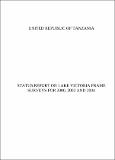Status report on Lake Victoria frame surveys for 2000, 2002 and 2004-Tanzania
View/
Author
Date
2005Type
Reportviews
downloads
Metadata
Show full item recordxmlui.dri2xhtml.METS-1.0.item-citation
Status report on Lake Victoria frame surveys for 2000, 2002 and 2004-Tanzania
Abstract/
This is a report of the third simultaneous Frame Survey conducted on Lake Victoria on 27 - 30th April 2004. The survey was carried out simultaneously between the three partner states sharing Lake Victoria. It involved a complete census of fishers, fishing crafts and gears. Also some economic features found at the landing sites such as markets, electricity, net and craft repair facilities, and accessibility by road all year round were enumerated. The 2004 Frame Survey results show that there were 575 landing sites, a drop of 3.3% as compared to 2002 results. Facilities at the landing sites continued to be scarce. Out of the total recorded landing sites only 176 were accessible by road all year round, 31 had bandas (fish sheds), 28 had electricity supply, 25 had pontoon/jetty, 16 had fish stores, 30 potable water, 49 toilet facilities, 218 net repair facilities and 235 boat repair facilities. Landing sites with working Beach Management Units (BMUs) were 466 while those with resident fisheries staff were only 49. There were 77,997 fishers and 22,653 fishing crafts as compared to 80,053 and 21,660 recorded in 2002. There was a general decrease in the use of gill net of mesh sizes below 4.5” and an increase in the mesh sizes 5” and above. The total number of gill nets increased by 37.1% from 425,888 recorded in 2002 to 583,699 in 2004. The number of long line hooks decreased by 33.3% from 4,608,998 recorded in 2002 to 3,081,885 in 2004. The Number of out board engines increased by 113.6% from 2,610 recorded in 2002 to 5,576 in 2004. The big increase in motorization may indicate that fishers are compelled to move further off shore in search of fish. Illegal gears such as beach seines and gill nets with mesh sizes below 5” continue to be used. In the 2004 survey there were 1,532 beach seines as compared to 1,454 recorded in 2002. However, there was a decrease in the use of gillnets below 5” mesh sizes which formed only 9.8% of the total number of gill nets as compared to 22.7% in the 2002 survey. It is highly recommended that partner states should put more efforts in curbing the use of illegal gears and try to control the fishing effort as much as possible. Local Authorities should be sensitised to improve facilities at the landing sites such as potable water, toilets, access roads, electricity, net and craft repair.

